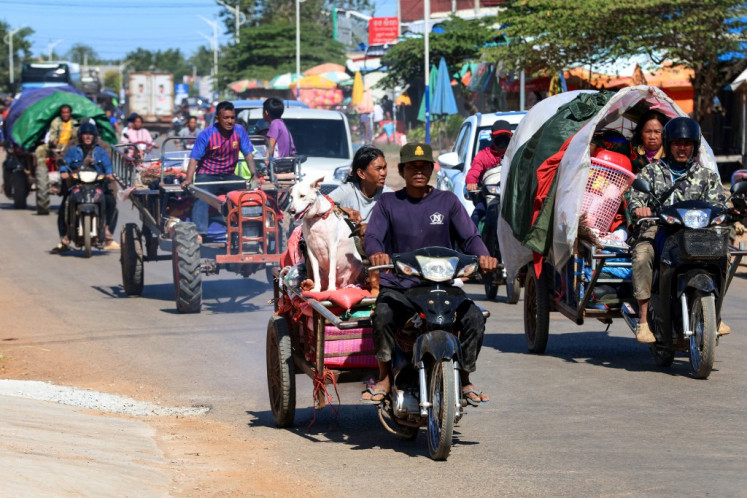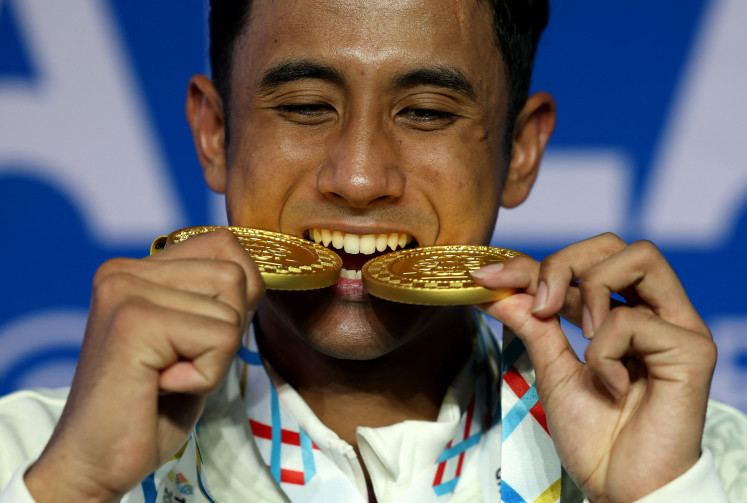Popular Reads
Top Results
Can't find what you're looking for?
View all search resultsPopular Reads
Top Results
Can't find what you're looking for?
View all search resultsPartnering the past present
Generation now: Contemporary portraits of Tanimbarese people in the Netherlands, taken by John Sasabone, as part of the museum’s current exhibition “Krijgers in de kerk, Tanimbarese portretten 1920/2009” (Warriors at the church, Tanimbarese portraits: 1920-2009)
Change text size
Gift Premium Articles
to Anyone
G
span class="caption" style="width: 398px;">Generation now: Contemporary portraits of Tanimbarese people in the Netherlands, taken by John Sasabone, as part of the museum’s current exhibition “Krijgers in de kerk, Tanimbarese portretten 1920/2009” (Warriors at the church, Tanimbarese portraits: 1920-2009).
Twenty-three years ago, the Dutch government gave the Moluccan community in the Netherlands a priceless gift: the Museum Maluku (MuMa) in Utrecht.
Since 1986, MuMa has sought to preserve and promote the material and immaterial heritage of the Dutch Moluccan community, through organizing exhibitions, conducting research and producing events, shows, workshops and debates. Recently, this scope has widened to include Moluccans all around the world.
With this in mind, Huib Akihary, the new MuMa director, and a troupe of Dutch Moluccan musicians and actors visited Jakarta and Ambon last month to help strengthen ties with local cultural communities and official institutes and to seek new ways of collaborating on cultural programs and projects.
“MuMa operates on the premise that the [Dutch] Moluccan community is an integral part of Dutch society while at the same time retaining its unique characteristics and strong ties to the area of origin, the Moluccas,” Akihary says.
Heritage site: The Museum Maluku (MuMa) in Utrecht, the Netherlands.
This vision balances the deeply entwined history of Molucca and the Netherlands, as well as the Dutch Moluccan community’s need to reconnect with their roots.
In 1951, around 12,500 Moluccans left their homeland for the Netherlands, in what was meant to be a temporary solution to the tense political situation in Indonesia that had arisen following the end of Dutch colonial rule.
A short-term return proved impossible, and from 1956 onward Dutch policymaking aimed at integration, a lengthy process that initially prevented Moluccans from traveling to Indonesia, for social and economic reasons.
In the 1980s, as the position of Moluccans in Dutch society improved, they were able to visit Indonesia; MuMa was established around the same time and opened to the public in 1990.
Reflecting today’s widespread Moluccan diaspora, MuMa has several partners around the world that share its interest in preserving and promoting Moluccan culture.
Way back when: A photo of a Tanimbarese man, taken in 1920 by Dutch Missionary Father Drabbe, as part of the museum’s current exhibition.
In Holland, along with the Dutch government and various Moluccan organizations, MuMa works with the Dutch Museum Association, Rijksmuseum Amsterdam, Royal Tropical Institute (KIT), Centraal Museum Utrecht, Aboriginal Art Museum Utrecht, the Foundation of Papua Heritage (PACE) and Museum Bronbeek Arnhem.
MuMa’s Indonesian partners include the Moluccan governor, Moluccan diplomats, the Museum Siwa Lima and the Rinamakana Foundation, both in Ambon, as well as the Dutch Embassy and the Erasmus Huis, both in Jakarta. MuMA also works with the Smithsonian Institute in Washington DC.
According to Akihary, the Moluccan community in Jakarta has been highly organized in preserving its heritage through societies and yayasan (foundations).
In August 2009, MuMA began a close collaboration with the glossy Jakarta-based magazine World of Maluku (WOM), which is edited by Samuel Wattimena.
“MuMa will be the correspondent and distributor for the magazine in the Netherlands,” Akihary says.
“MuMa also has started talks with Erasmus Huis to organize a yearly Pasar Maluku [Moluccan market] in Jakarta, an event to bring Moluccans and Moluccan culture from the Netherlands and Indonesia together in Jakarta.”
Akihary further hopes to establish contact with Moluccan communities in California and Australia.
Priceless: Antique Tanimbarese jewelry, which is part of the museum’s current exhibition.
Following MuMa’s aim to explore the continuum between the Netherlands’ and Molucca’s shared past and present, the museum’s current exhibition “Krijgers in de kerk, Tanimbarese portretten 1920/2009” (Warriors in the church, Tanimbarese portraits: 1920–2009) displays portraits made by Dutch missionary Father Drabbe in 1920 of the people of the Tanimbar islands in the Moluccas, and artifacts from the period, as well as their modern counterparts.
“One of the portrayed women, Atanube, has great-grandchildren living in the Netherlands. We commissioned new portraits of Tanimbarese people living in the Netherlands, and two were her great-grandchildren,” Akihary says.
Similarly, upcoming exhibitions are “The Huwae Connection”, which will display the art of two generations of artists from the Moluccan Huwae family; “Ambon: Rebuilding and reconciliation after the ‘Kerusahan’”; and “Tattoo: Pimping up your Moluccan body”, which aims to engage Moluccan youth.
Akihary’s recent trip to Indonesia was at the behest of Florence Suhusilawane, head of the Maluku cultural affairs and tourism agency, who was supported by the Maluku governor.
“A large delegation visited the Museum Maluku last May to invite us officially and to request our support in promoting Moluccan culture and tourism,” Akihary says.
Making music: Performers from the Moluccan Music Theatre Ensemble at a cultural park in Karang Panjang, Ambon late August this year.
During the trip, Akihary and theatre/music director Anis de Jong organized a music-theater show, Paku Coklat (The Chocolate Nail), which was performed by the Moluccan Music Theater Ensemble (MMTE), comprising Ambonese artists, Dutch Moluccan musicians and the Dutch Moluccan theater group DeltaDua.
The project, which was sponsored by the Moluccan cultural affairs and tourism agency, the provincial Moluccan secretary, the Dutch Embassy in Jakarta, and a private Dutch–Moluccan fund cost 35,000 euros in total. Two shows were performed on Aug. 27 and Aug. 28 at Taman Budaya in Karang Panjang, Ambon.
“The musical event in Ambon was wonderful, a good example of how Moluccans from the Netherlands and Ambon can cooperate closely and successfully,” Akihary says.
“It has resulted in a mutual friendship, respect and the willingness to continue in working together in preserving and promoting Moluccan culture and starting new projects in 2010 and 2011.”
The triumph of the musical has led to several tours for the MMTE in June 2010, in both the Netherlands and Indonesia, as well as a slot in next year’s Tong Tong festival (May 19–30) in the Hague, which is the world’s largest Eurasian arts festival.
He adds the show was also an important step in a larger-scale musical theater collaboration between DeltaDua and MuMa, which started last year. The partners, jointly named the Baku Dapat Orchestra, are developing an opera about the life of legendary Moluccan freedom fighter Martha Christina (1800–1818), which is due to be performed on at Benteng Durrstede on Saparua Island, Molucca, in 2011.
On display: The poster for the museum’s current exhibition “Krijgers in de kerk, Tanimbarese portretten 1920/2009” (Warriors at the church, Tanimbarese portraits: 1920-2009) displays portraits made by Dutch missionary Father Drabbe in 1920 of the people of the Tanimbar islands in Molucca.
“For the opera’s music, director Anis de Jong wants to find a nice mixture of musical influences that have come to Molucca over the last centuries and create new arrangements for the traditional lagu lagu [folk songs], using traditional instruments like the totobuang [chime gong], tifa [dance instrument] and raban [one-sided drum] in combination with guitar, bass, violin and flute and the main Moluccan instrument: the human voice,” he says.
“The traditional Moluccan songs that everyone knows by heart will be arranged in new rhythms and orchestrations based on Portuguese musical influences as fado [mournful guitar music], mixed with old Dutch maritime songs from the 17th century, classical Western opera music and other modern music such as jazz.”
Akihary will return to Jakarta in December to start talks with sponsors that have an interest in supporting MuMa’s future projects.
While MuMa is obviously committed to recovering and preserving the past, Akihary stresses the importance of working toward the countries’ shared futures, in terms of cultural partnerships.
“The relationship [between the Netherlands and Indonesia] stretches over centuries starting around 1600 and is full of events, both good and bad ones. My view is to look ahead and keep on working on good relations with the Dutch and with Indonesians.”
— Photos Courtesy of Museum Maluku Negri Belanda















